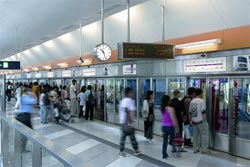New Subway Control Works With WLAN

<br>
This development is featured in the current issue of the research magazine Pictures of the Future. The solution was developed by Siemens global research, Corporate Technology (CT).
Because the concept is also suitable for retrofitting into existing stretches, the construction of costly new subway lines can be avoided or postponed. The Trainguard MT system registers the position of each train and automatically adjusts the distance to the following train.
The fixed interval between trains of about three minutes, which subways have used until now, can be reduced to as little as 80 seconds. Trainguard MT is now in operation in several major cities around the world including Beijing, Istanbul and London.
Subways are one of the major arteries of big cities and they transport millions of people every day. But subway construction is a big job. This makes it difficult to adapt subways to increasing passenger volumes. One obstacle to raising the capacity of a subway has been the fixed interval between two trains. This interval is based on maintaining the potential maximum braking distance of the following train, which is typically around one kilometer.
If it were known exactly where each train was and how fast it was going at any given moment, the interval between trains could be adjusted to match the actual required braking distance and the trains could run closer to one another. Until now, the wireless technology needed to maintain an uninterrupted flow of this type of data between the train and the control center has been lacking.
Siemens CT turned to WLAN technology and developed a solution that uses access points installed along the stretch of a subway line. Fiber-optic cables connect these access points to each other and to the control site. In this way a train can stay in contact with the control center.
The access points are placed about 250 meters apart – depending on the subway – and the WLAN communications are configured in such a way that passengers' computers and cell phones don't cause any interference. The system detects the position of a train to within a few centimeters. When a train leaves a stop, the following train gets the green light to pull in as soon as the required interval is reached. If a train brakes, the following train will automatically also be braked if necessary.
In Beijing, Trainguard MT is in operation on two new subway lines, covering a total of 31 kilometers. Every day these trains transport around one million commuters. In Istanbul Siemens retrofitted Trainguard MT into a subway line without interrupting the service.
Media Contact
More Information:
http://www.siemens.com/innovationnewsAll latest news from the category: Transportation and Logistics
This field deals with all spatial and time-related activities involved in bridging the gap between goods and people, including their restructuring. This begins with the supplier and follows each stage of the operational value chain to product delivery and concludes with product disposal and recycling.
innovations-report provides informative reports and articles on such topics as traffic telematics, toll collection, traffic management systems, route planning, high-speed rail (Transrapid), traffic infrastructures, air safety, transport technologies, transport logistics, production logistics and mobility.
Newest articles

High-energy-density aqueous battery based on halogen multi-electron transfer
Traditional non-aqueous lithium-ion batteries have a high energy density, but their safety is compromised due to the flammable organic electrolytes they utilize. Aqueous batteries use water as the solvent for…

First-ever combined heart pump and pig kidney transplant
…gives new hope to patient with terminal illness. Surgeons at NYU Langone Health performed the first-ever combined mechanical heart pump and gene-edited pig kidney transplant surgery in a 54-year-old woman…

Biophysics: Testing how well biomarkers work
LMU researchers have developed a method to determine how reliably target proteins can be labeled using super-resolution fluorescence microscopy. Modern microscopy techniques make it possible to examine the inner workings…





















